PARK WATCH Article June 2024 |
The State Government’s landmark decision to end native forest logging by 1 January 2024 was welcomed by the Victorian community, but is it really over? Blake Nisbet, Nature Conservation Campaigner, takes a look at logging on private land
Logging loopholes are unravelling across the state. We’re now observing native forest logging stealthily roll from state forests to private land, in some cases both a figurative and literal hop over the fence.
A monumental Supreme Court ruling on protections for Greater and Yellow-bellied Gliders was announced in late 2022, which largely halted native forest logging throughout 2023 up to the 2024 ban.
But in some areas, like the Central Highlands, native forest logging may be more active now than in the bad old days pre-2022, before court cases stymied the destruction and the state-wide ban kicked in.
Over the last 18 months, VNPA has been made aware of native forest logging (commenced or planned to) on four privately-owned forest blocks in the Central Highlands, as well as in western Victoria and East Gippsland. It’s likely this loophole is being exploited across the state. Wildlife such as Critically Endangered Leadbeater’s Possums, Vulnerable Yellow-bellied Gliders and Endangered Long-footed Potoroos are threatened by these damaging operations.
Same same but different
In many ways, private land logging comes with more challenges than its public counterpart. It’s important to understand how it operates on private land, compared to in state forests.
On private land:
- Logging is approved and regulated by poorly-resourced and ill-equipped local governments instead of Victorian Government and their Office of the Conservation Regulator (OCR).
- The sources of permission for logging are often historical permits with no conditions or expiry dates.
- The logging is often difficult to monitor, due to access restrictions on private land and a lack of transparency.
- Pre-harvest survey requirements are more relaxed and are unlikely to detect resident populations of threatened plants and animals that require protections from logging.
- Protections for environmental values such as threatened plants and animals are weaker, and inadequate for mitigating any ecological risk and impacts.
- The risks to threatened plants, animals and communities from future logging is not assessed. This would determine whether additional protections are required during the Victorian Government’s assessments in accordance with the Regional Forestry Agreements.
The rules governing native forest logging on private land are set out in the Code of Practice for Timber Production. However, the sections that apply can be cherry-picked and don’t include all the species-specific protections ordinarily applied in state forests. For example, under the Code, native forest logging in state forests was prohibited within 200m of a verified Leadbeater’s Possum.
On private land, that provision doesn’t directly apply. VNPA has observed satellite imagery (see photo above) that shows recent native forest logging on private land that breaches the 200m Leadbeater’s Possum special protection zones.
It’s not just the Code that sets out rules and regulations for logging on private land. Many pieces of state and Commonwealth legislation must be complied with. Victoria’s key nature laws, the Flora and Fauna Guarantee Act 1988 (FFG Act), also demand 200m special protection zones around Leadbeater’s Possum records.
Local governments are required to give careful consideration to these laws when giving the tick to private land proposals on. Councils, especially smaller regional ones, are under-resourced and appear ill-equipped to deal with the complexities of regulating native forest logging.
Our threatened wildlife and their homes are the unwitting victims of poor regulation and decision-making. There are hundreds of thousands of hectares of merchantable (suitable for sale) forest vegetation on private land, illustrating the scale of this issue.
The burden placed on local governments to regulate native forest logging on private land is substantial, and comes with major legal, political and compliance risks.
Consideration and approvals of logging operations by councils suck up critical time and resources. Paired with native forest loggings’ loss of social licence, this leaves local councils and shires vulnerable to legal challenges by the public and increases in political pressure.
We’ve written to 58 rural councils expressing the complexities and risks faced if they approve native forest logging operations on private land. We’ve also written to relevant state ministers to align their native forest logging ban by closing this private land logging loophole.
Tell the government to put an end to the private land logging loophole
- Read the latest full edition of Park Watch magazine
- Subscribe to keep up-to-date about this and other nature issues in Victoria
- Become a member to receive Park Watch magazine in print

